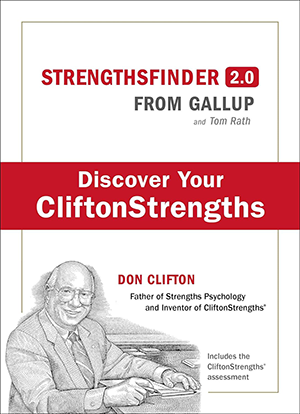Summary by Lisa Buck

Do you have the opportunity to do what you do best every day? According to Gallup research, you probably don’t. Our natural talents too often go untapped.
And while it is easy to describe our acquired expertise (“I’m a corporate attorney specializing in mergers and acquisitions”), most of us struggle to identify our natural talents.
In 1999, Gallup created StrengthsFinder1, an online assessment and companion book that helps individuals identify their natural talents. StrengthsFinder encourages people to build their careers and lives around their strengths instead of trying to “fix” their weaknesses. Gallup maintains that people have more potential for growth when they invest energy in developing their strengths rather than correcting their deficits.
Gallup defines a talent as a “naturally recurring pattern of thought, feeling or behavior that can be productively applied.” The dominant talents that you identify in StrengthsFinder are not necessarily things you have mastered. Rather, talents are the areas where you have the most potential to succeed. The most successful people start with the dominant talent, then add skills, knowledge, and practice to the mix. Knowledge and practice amplify the talents that come naturally to you.
According to Gallup, each of us has a unique combination of 34 talents, with some being dominant. This article will touch on just a few of the 34 named talents. The 34 talents are categorized into 4 domains: Executing, Influencing, Relationship-Building, and Strategic Thinking.
Domains of Strengths
Executing | Influencing | Relationship-Building | Strategic Thinking |
| Achiever | Activator | Adaptability | Analytical |
| Arranger | Command | Connectedness | Context |
| Belief | Communication | Developer | Futuristic |
| Consistency | Competition | Empathy | Ideation |
| Deliberative | Maximizer | Harmony | Input |
| Discipline | Self-Assurance | Includer | Intellection |
| Focus | Significance | Individualization | Learner |
| Responsibility | Woo | Positivity | Strategic |
| Restorative | | Relator | |
The most commonly occurring talent is Achiever, which shows up in about 31% of results.2 Achiever has a constant need for achievement. Achiever feels that every day starts at zero. By the end of the day, they must achieve something tangible in order to feel their best. If the day (even a weekend or vacation day) passes without some sort of achievement, they feel dissatisfied.
Responsibility is the second most commonly occurring talent. Responsibility follows everything, big or small, through to completion. They are utterly dependable.
Learner is the third most common talent. As the name implies, Learner loves to learn new facts, skills and knowledge. They find the process of learning exciting and are not intimidated by unfamiliar information. They have a need for extreme competency.
My dominant talent is Harmony. Harmony seeks peace and tries to find consensus. Harmony steers people away from conflict and toward reconciliation. (Perhaps that is why I practiced corporate law, which involves negotiating deals and contract terms.) Harmony doesn’t enjoy debate for its own sake and can’t believe how much time is wasted by people trying to impose their views on others (especially in an election year!)
Having the opportunity to focus on your dominant talents is referred to as being in the “strengths zone.” If you are in the strengths zone at work, research shows you are more likely to be engaged with coworkers and clients, you will be more productive, and you will be happier.
StrengthsFinder includes action ideas for how to use your dominant talents at work and how to avoid roadblocks that come along with it. Here are some examples:
An Achiever should seek roles where they can launch initiatives and new projects. A leader with dominant Achiever will set high goals for their team and motivate them to do more. Achiever likes to be productive and may find meetings boring, so they should learn the objectives of a meeting ahead of time and help ensure that it stays productive and efficient.
Someone with Responsibility as a strength likes to take ownership of every project they are involved in. They may sometimes find it difficult to say no or to refuse opportunities. For this reason, they should be selective. They will not sacrifice quality for speed. Responsibility works best when given freedom to follow through on projects, rather than having constant check-ins with their supervisor.
A Learner thrives in work environments where they are expected to learn a lot about a new subject matter in a short period of time, or in a field with constantly changing technologies or regulations.
By getting clear on your dominant talents, you can focus on your greatest opportunities for success. Use your dominant talents and invest in your strengths to excel in your role. And by understanding your team members better, you can cultivate a more productive and positive work culture, where each person can do what they do best.
To take the StrengthsFinder assessment, go to https://store.gallup.com/c/en-us/1/cliftonstrengths. For $60, you will receive all 34 talents in order of dominance, or for $25 you will receive your top 5 talents. You’ll need about 30 minutes of uninterrupted time to take the assessment. It consists of 177 timed questions. You get 20 seconds for each question. After you have completed the assessment, you will receive an action planning guide with strategies to apply your strengths.

Lisa Buck practiced corporate law in Minneapolis before making a career pivot into photography. When she isn’t writing, you can find her taking headshots of attorneys and other folks at Lisa Buck Photography.
Notes
1. In 2015, Gallup changed the name of the assessment StrengthsFinder to “CliftonStrengths”. This article refers to the assessment by its more popular name, StrengthsFinder.
2. Conversely, Command is the least often occurring talent.